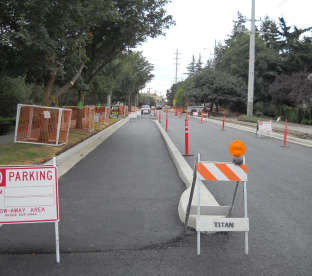Seattle’s Department of Transportation is holding a series of Bicycle Master Plan public meetings, as the city embarks on something of a sea change in its strategy for bicycling infrastructure. In a major shift, the city is admitting that simply painting bike lanes or “sharrows,” especially in the highly trafficked downtown core, isn’t working.
Physically separate bike lanes, also called cycle tracks, are in the offing. Tom Fucoloro of Seattle Bike Blog writes: “The plan so far includes 523 miles of facilities to build or upgrade.” (He’s also put up a draft map of those changes.)
The next public meeting is set for November 13, 2012, at the UW’s Gould Hall, from 5:30 to 7:30 p.m. An online meeting is scheduled for November 15, from noon to 1 p.m.
Public feedback is important, and not just from people who ride bicycles around town currently. It’s just as–if not more–illuminating to hear from the non-cycling crowd, to help challenge assumptions being made. With the introduction of neighborhood greenways, SDOT has at long last begun to include the aspirations of people who don’t dress head-to-toe in lycra before heading out for a century.
It is as if, to exaggerate for effect, sidewalks catered primarily to marathoners, and planners patted themselves on the back when, occasionally, there were sidewalks where retirees and their grandchildren could walk.

It’s a habit of thinking. At a recent public meeting, an SDOT representative spoke about not having cycle tracks on a downhill slope, but reintroducing a sharrow, since cyclists would be able to keep up with cars. At one stroke, about 80 percent* of potential cyclists are pushed aside, in favor of the racing commuter trying to make up some time. It’s understandable from SDOT, because people in cars almost always want to go just as fast as possible.
But while bicycles can be fast (faster than cars in many in-city situations), that’s not why many people ride–they’re not always looking to set a speed record on a downhill. That’s why their bikes have brakes, to keep to a comfortable speed.
In-city cycling doesn’t need to exceed 12 or 15 mph to get everyone where they need to go in a reasonable amount of time. It’s safer for all concerned, lets cyclists of all ages and experiential-stripes mingle, and everyone can arrive at their destination without trailing rivers of sweat if they don’t want to.
The perspiring, disheveled look is a real concern of non-cyclists, which arises from so many current commuters riding as if they’re race training. With a low enough gear and a relaxed attitude, lightly increased heart and breathing rates should be all people spot when you dismount in your natty woolen togs from Hub & Bespoke. (Full disclosure: I’m a satisfied customer. More pressing concerns, says SDOT research: safety, weather, hills. People who ride regularly tend to discount weather and hills as there’s not much to be done about either.)
Downtown’s vehicular density can also fuel a potent mix of testosterone and adrenaline; the easy-going office worker transforms into the douchebag biking ambassador. (In his mind, he’s in a fight for his life in the urban jungle.)
In 1992, 20 percent of cyclists downtown were women. By 2011, total cyclists had increased 200 percent, but only 22 percent of the 3,330 bicyclists spotted in a one-day count were women. In a city with as many outdoorsy women as Seattle boasts–trust me, REI membership is not 22 percent female–that’s not an accident. It’s a discriminatory by-product.
It’s been said elsewhere, but the (male) racing road cyclist just isn’t the model for good bike infrastructure. Tom Fucoloro again:
Remember that we are building a plan for people who are afraid or unconvinced by cycling today. We are not here to merely represent the needs of people who are already cycling regularly. A facility that is “good enough” for you is not the kind of facility that is going to get a significant return on investment in terms of encouraging more people to cycle.
It is significant that Seattle’s bike lobby is identified so strongly with the Cascade Bicycle Club, itself so strongly identified with its perennially popular Seattle-to-Portland ride. (Join them Sunday, November 11, for a 56-mile loop.) Advocacy for “people who happen to ride bikes” (rather than firmly identified cyclists) and greenways isn’t absent, but the CBC’s lobbying strategy has been conflicted, and has even sounded at times like douchebag-cyclist advocacy. (I mean this in terms of wider perception–there are fewer communication gaps greater than that between someone who’s almost been killed while on a bicycle and a non-cyclist driving a car.)
What Seattle needs more of is the biking-mom-with-kids lobby, the biking-professional-woman lobby, the biking-neighborhood-maven lobby. Just look at what the City Council’s Sally Bagshaw has accomplished by championing greenways. Focusing on the social elements of cycling–often less expensive and more sustainable–is what can transform bike advocacy from (entitled) niche interest to broad-based demand. Like sidewalks that everyone expects to be able to use.
UPDATE/POSTSCRIPT: Cascade Bicycle Club’s Craig Benjamin emailed me their recent memo to SDOT, which contains this statement up front: “We work to serve the roughly two-thirds of Seattleites who want to bicycle more often but don’t because we haven’t made the investments necessary for them to feel safe and comfortable.” To back that up, he also provided these links:
- Bicycling to school shouldn’t require a police escort
- The future of bicycling in Seattle is up to us
- On a mission, but to where?
- 2012 Seattle Bicycle Report Card: Cities across America outpace Seattle in bikeability
- Business leaders gather to talk—and map—bikes
*This percentage is pure speculation on my part. But imagine if this was the case.
